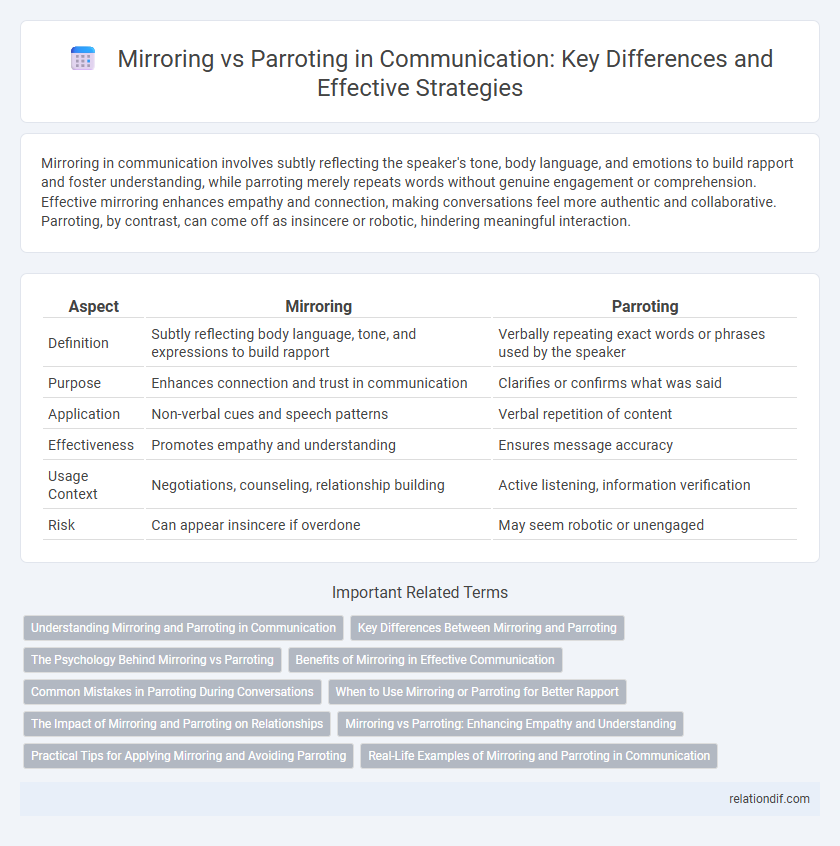Mirroring in communication involves subtly reflecting the speaker's tone, body language, and emotions to build rapport and foster understanding, while parroting merely repeats words without genuine engagement or comprehension. Effective mirroring enhances empathy and connection, making conversations feel more authentic and collaborative. Parroting, by contrast, can come off as insincere or robotic, hindering meaningful interaction.
Table of Comparison
| Aspect | Mirroring | Parroting |
|---|---|---|
| Definition | Subtly reflecting body language, tone, and expressions to build rapport | Verbally repeating exact words or phrases used by the speaker |
| Purpose | Enhances connection and trust in communication | Clarifies or confirms what was said |
| Application | Non-verbal cues and speech patterns | Verbal repetition of content |
| Effectiveness | Promotes empathy and understanding | Ensures message accuracy |
| Usage Context | Negotiations, counseling, relationship building | Active listening, information verification |
| Risk | Can appear insincere if overdone | May seem robotic or unengaged |
Understanding Mirroring and Parroting in Communication
Mirroring in communication involves subtly reflecting the speaker's body language, tone, or emotions to build rapport and deepen understanding, enhancing interpersonal connection. Parroting, by contrast, is the direct repetition of words without emotional or contextual adaptation, often perceived as insincere or robotic. Effective communication leverages mirroring to foster empathy and trust, whereas parroting may hinder authentic dialogue and reduce engagement.
Key Differences Between Mirroring and Parroting
Mirroring involves subtly reflecting another person's body language, tone, or emotions to build rapport and foster understanding, while parroting is simply repeating someone's words without capturing their underlying feelings or intent. Mirroring enhances empathetic connection by aligning nonverbal cues, whereas parroting often comes across as mechanical and may hinder genuine communication. Effective communication leverages mirroring to promote trust and active listening, making interactions more meaningful compared to the superficial nature of parroting.
The Psychology Behind Mirroring vs Parroting
Mirroring involves subtly replicating another person's body language, tone, and expressions to build rapport and foster empathy, activating mirror neurons that promote emotional connection. Parroting, however, is the mechanical repetition of words without understanding, often leading to disengagement and perceived insincerity. Psychological studies reveal that mirroring enhances trust and communication effectiveness, whereas parroting can hinder authentic interaction and relationship development.
Benefits of Mirroring in Effective Communication
Mirroring enhances effective communication by fostering empathy and building trust, allowing individuals to feel understood and valued during conversations. This technique encourages active listening and genuine connection, which improves rapport and reduces misunderstandings. Unlike parroting, mirroring adapts to the communicator's tone and body language, creating a more natural and impactful interaction.
Common Mistakes in Parroting During Conversations
Parroting during conversations often leads to communication breakdown by causing misunderstandings and frustration when responses lack genuine comprehension or empathy. Common mistakes include repeating words verbatim without adapting tone or context, resulting in robotic and insincere interactions that hinder rapport building. Unlike mirroring, which incorporates subtle body language and emotional cues to foster connection, parroting fails to engage meaningfully, diminishing conversational effectiveness.
When to Use Mirroring or Parroting for Better Rapport
Mirroring involves subtly reflecting the other person's body language, tone, and pace to create a sense of empathy and connection, making it effective during initial conversations and rapport-building phases. Parroting, which entails repeating key phrases verbatim, is best used for clarification and demonstrating active listening in detailed discussions or negotiations. Choosing mirroring or parroting depends on the communication goal: mirroring fosters emotional bonding, while parroting ensures understanding and responsiveness.
The Impact of Mirroring and Parroting on Relationships
Mirroring enhances relationships by fostering empathy and deeper understanding through subtle imitation of body language and tone, leading to increased trust and connection. Parroting, which involves repeating words without genuine comprehension, can hinder communication by causing frustration and perceived insincerity. Effective communication relies on mirroring to build rapport, while parroting often results in superficial interactions.
Mirroring vs Parroting: Enhancing Empathy and Understanding
Mirroring involves subtly reflecting the speaker's emotions and body language to create a sense of empathy and connection, while parroting simply repeats words without genuine understanding. Effective mirroring enhances communication by validating feelings and encouraging deeper dialogue, fostering trust and mutual respect. Parroting often feels mechanical and can hinder authentic engagement, making mirroring a superior technique for meaningful interpersonal interactions.
Practical Tips for Applying Mirroring and Avoiding Parroting
Effective communication utilizes mirroring by subtly reflecting the speaker's tone, body language, and key phrases to build rapport and demonstrate active listening. Avoid parroting by rephrasing ideas in your own words, which shows genuine understanding and keeps conversations engaging. Practical tips include maintaining natural eye contact, matching vocal pace without imitation, and summarizing points to confirm clarity while encouraging open dialogue.
Real-Life Examples of Mirroring and Parroting in Communication
Mirroring in communication involves subtly reflecting the speaker's body language, tone, or words to build rapport, such as a manager nodding and matching a colleague's posture during a negotiation to create trust. Parroting, by contrast, means repeating the speaker's exact words or phrases, often observed in customer service when agents echo phrases like "I understand your frustration" to show acknowledgment without genuine empathy. Effective communicators use mirroring to foster connection and parroting to ensure clarity and confirm understanding in real-life interactions.
mirroring vs parroting Infographic

 relationdif.com
relationdif.com